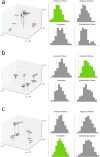Multidimensional representation of odors in the human olfactory cortex
- PMID: 26991044
- PMCID: PMC6867239
- DOI: 10.1002/hbm.23164
Multidimensional representation of odors in the human olfactory cortex
Abstract
What is known as an odor object is an integrated representation constructed from physical features, and perceptual attributes mainly mediated by the olfactory and trigeminal systems. The aim of the present study was to comprehend how this multidimensional representation is organized, by deciphering how similarities in the physical, olfactory and trigeminal perceptual spaces of odors are represented in the human brain. To achieve this aim, we combined psychophysics, functional MRI and multivariate representational similarity analysis. Participants were asked to smell odors diffused by an fMRI-compatible olfactometer and to rate each smell along olfactory dimensions (pleasantness, intensity, familiarity and edibility) and trigeminal dimensions (irritation, coolness, warmth and pain). An event-related design was implemented, presenting different odorants. Results revealed that (i) pairwise odorant similarities in anterior piriform cortex (PC) activity correlated with pairwise odorant similarities in chemical properties (P < 0.005), (ii) similarities in posterior PC activity correlated with similarities in olfactory perceptual properties (P <0.01), and (iii) similarities in amygdala activity correlated with similarities in trigeminal perceptual properties (P < 0.01). These findings provide new evidence that extraction of physical, olfactory and trigeminal features is based on specific fine processing of similarities between odorous stimuli in a distributed manner in the olfactory system. Hum Brain Mapp 37:2161-2172, 2016. © 2016 Wiley Periodicals, Inc.
Keywords: amygdala; mental representation; piriform; similarity; smell; trigeminal.
© 2016 Wiley Periodicals, Inc.
Figures








References
-
- Amoore JE, Johnston JW Jr, Rubin M (1964): The stereochemical theory of odor. Sci Am 210:42–9. - PubMed
-
- Anderson AK, Christoff K, Stappen I, Panitz D, Ghahremani DG, Glover G, Gabrieli JDE, Sobel N (2003): Dissociated neural representations of intensity and valence in human olfaction. Nat Neurosci 6:196–202. - PubMed
-
- Arctander S (1994): Perfume and flavor materials of natural origin (Allured Publishing, Carol Stream (Illinois), 1994).
-
- Ashby FG, Lee WW (1991): Predicting similarity and categorization from identification. J Exp Psychol Gen 120:150. - PubMed
-
- Benjamini Y, Hochberg Y (1995): Controlling the false discovery rate: A practical and powerful approach to multiple testing. J Roy Stat Soc Ser B (Methodological) 57:289–300.
MeSH terms
LinkOut - more resources
Full Text Sources
Other Literature Sources

